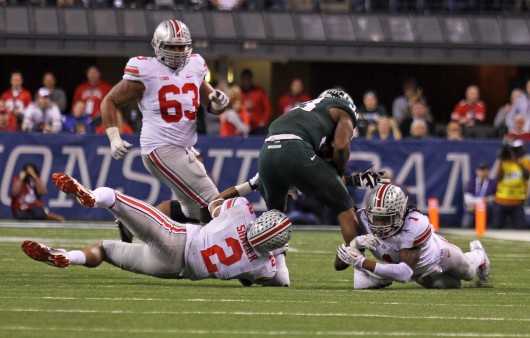
Junior linebacker Ryan Shazier (2) and redshirt-junior cornerback Bradley Roby (1) make a tackle during the Big Ten Championship Game Dec. 7 in Indianapolis. OSU lost to Michigan State, 34-24. Credit: Shelby Lum / Photo editor
INDIANAPOLIS – The Ohio State defense allowed six touchdowns and 603 total yards to the Michigan offense in the two teams’ regular-season finale Nov. 30, but that didn’t cost OSU its chance at a second consecutive undefeated season.
One week later, the 34 points it gave up to the Michigan State offense in the Big Ten Championship Game did.
That defense allowed 438 total yards, four touchdowns and two field goals Saturday as OSU (12-1, 8-1) fell to the Spartans (12-1, 9-0), 34-24.
Although the Buckeyes were able to score 24 consecutive points and put up 374 total yards against a Spartans defense that came into the game allowing just 11.8 points and 237.7 total yards per game, the plays allowed by its own defense proved to be too much.
OSU gave up five plays of 20 or more yards to the Spartans on Saturday. Three of those — a 72-yard pass from Michigan State redshirt-sophomore quarterback Connor Cook to redshirt-junior wide receiver Keith Mumphery, a 33-yard pass from Cook to redshirt-junior wide receiver Tony Lippett and a 26-yard run by redshirt-junior running back Jeremy Langford — were touchdowns. A 48-yard pass completion from Cook to sophomore wide receiver Macgarrett Kings Jr. set up the Spartans’ other touchdown, while a 34-yard run by Langford set up one of the Spartans’ field goals.
“It is what it is,” defensive coordinator Luke Fickell said of his unit’s struggles. “Guys got to make plays. We got to put them in situations where they can make plays. There’s no finger-pointing.”
For the second straight week, the OSU defense allowed its opponent’s quarterback to have a career-best performance. After giving up 451 passing yards and four touchdowns to Michigan redshirt-junior quarterback Devin Gardner Nov. 30, the Buckeyes allowed Cook to throw for 304 yards.
“Disappointed with our pass defense,” coach Urban Meyer said after Saturday’s loss. “We have to get this fixed. We’re going to get back to work.”
Junior linebacker Ryan Shazier said the defense’s struggles to defend the pass against Michigan State were a result of miscommunication.
“We just got to do better,” Shazier said. “Everybody did their best out there, and we just got to rally up and just get ready for the next week, just keep practicing.”
That struggling pass defense’s cause was not helped when redshirt-junior cornerback Bradley Roby went down with a knee injury in the third quarter. He would eventually return to the game, but Meyer said it hurt the OSU defense not to have him on the field for a stretch.
“Take a great player off the field, that’s an issue,” Meyer said of Roby, adding that sophomore cornerback Armani Reeves “didn’t screw it up” and played fine when he entered the game in Roby’s place.
Although the Michigan State offense ranks just 83rd nationally with 384.6 total yards per game and 60th nationally with 29.8 points per game, Fickell said the quality of that unit was another factor in OSU’s defensive struggles.
“You got to give (Michigan State) credit,” Fickell said. “They did a good job. (Cook) threw the ball in the right spots and guys got to cover, guys got to rush, guys got to get there when they pressure.”
Still, as OSU prepares to finish its season in what will likely be a BCS bowl game, its defense has to bounce back. After giving up 34 or more points just twice in its first 11 games, OSU has allowed that many points in each of its last two games.
Fickell said the defense has to “get better as a group.”
“Football’s the greatest team sport known to man because it takes 11 guys,” Fickell said. “You have 10 (defensive players playing well) out there and they’re going to find that one guy. That’s what we got to make sure we do a better job (of) is all stick together through those adverse situations.”


